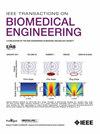Ventricular Arrhythmia Classification Using Similarity Maps and Hierarchical Multi-Stream Deep Learning
IF 4.4
2区 医学
Q2 ENGINEERING, BIOMEDICAL
引用次数: 0
Abstract
使用相似性图谱和分层多流深度学习进行室性心律失常分类。
目的:室性心律失常是导致心脏性猝死的主要心律失常。我们解决了室性心动过速(VT)、室颤(VF)和非室性节律(NVR)之间的分类问题:为了解决区分室速和室颤这一难题,我们开发了相似性图谱--一套新颖的特征,旨在捕捉心电图轨迹中的规律性。这些相似性图与通过可学习帕尔岑带通滤波器和衍生特征提取的特征相结合,可区分 VT、VF 和 NVR。为了结合这些不同特征的优势,我们提出了分层多流 ResNet34 架构:我们的实证结果表明,相似性图显著提高了区分 VT 和 VF 的准确性。总体而言,所提出的方法实现了 89.68% 的平均类灵敏度,对 VT 的单类灵敏度为 81.46%,对 VF 的单类灵敏度为 89.29%,对 NVR 的单类灵敏度为 98.28%:结论:所提出的方法对室性心律失常的检测和分类具有很高的准确性:意义:正确检测和分类心室颤动和室性心动过速对于有效干预、开发新的疗法和转化医学至关重要。
本文章由计算机程序翻译,如有差异,请以英文原文为准。
求助全文
约1分钟内获得全文
求助全文
来源期刊

IEEE Transactions on Biomedical Engineering
工程技术-工程:生物医学
CiteScore
9.40
自引率
4.30%
发文量
880
审稿时长
2.5 months
期刊介绍:
IEEE Transactions on Biomedical Engineering contains basic and applied papers dealing with biomedical engineering. Papers range from engineering development in methods and techniques with biomedical applications to experimental and clinical investigations with engineering contributions.
 求助内容:
求助内容: 应助结果提醒方式:
应助结果提醒方式:


